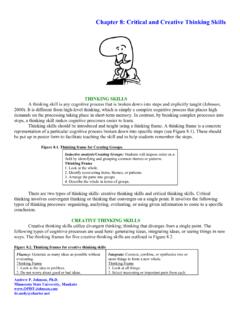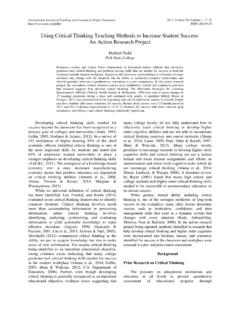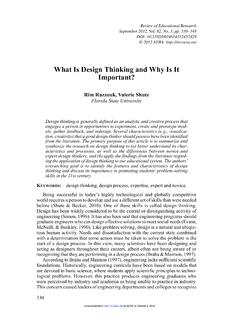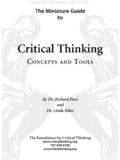Transcription of Overview of Systems Thinking
1 Overview of Systems ThinkingDaniel Aronsonystems Thinking has its foundation in the field ofsystem dynamics, founded in 1956 by MITprofessor Jay Forrester. Professor Forresterrecognized the need for a better way of testingnew ideas about social Systems , in the same waywe can test ideas in engineering. Systems thinkingallows people to make their understanding ofsocial Systems explicit and improve them in thesame way that people can use engineeringprinciples to make explicit and improve theirunderstanding of mechanical Systems Thinking ApproachThe approach of Systems Thinking isfundamentally different from that of traditionalforms of analysis. Traditional analysis focuses onthe separating the individual pieces of what isbeing studied; in fact, the word analysis actuallycomes from the root meaning to break intoconstituent parts.
2 Systems Thinking , in contrast,focuses on how the thing being studied interactswith the other constituents of the system a set ofelements that interact to produce behavior ofwhich it is a part. This means that instead ofisolating smaller and smaller parts of the systembeing studied, Systems Thinking works byexpanding its view to take into account larger andlarger numbers of interactions as an issue is beingstudied. This results in sometimes strikinglydifferent conclusions than those generated bytraditional forms of analysis, especially when whatis being studied is dynamically complex or has agreat deal of feedback from other sources, internalor character of Systems Thinking makes itextremely effective on the most difficult types ofproblems to solve: those involving complex issues,those that depend a great deal dependence on thepast or on the actions of others, and thosestemming from ineffective coordination amongthose involved.
3 Examples of areas in whichsystems Thinking has proven its value include: complex problems that involvehelping many actors see the bigpicture and not just their part of it Recurring problems or those that havebeen made worse by past attempts tofix them Issues where an action affects (or isaffected by) the environmentsurrounding the issue, either thenatural environment or thecompetitive environment Problems whose solutions are notobviousUse of Systems ThinkingAn example that illustrates the difference betweenthe Systems Thinking perspective and theperspective taken by traditional forms of analysisis the action taken to reduce crop damage byinsects. When an insect is eating a crop, theconventional response is to spray the crop with apesticide designed to kill that insect.
4 Putting asidethe limited effectiveness of some pesticides andthe water and soil pollution they can cause,imagine a perfect pesticide that kills all of theinsects against which it is used and which has noside effects on air, water, or soil. Is using thispesticide likely to make the farmer or companywhose crops are being eaten better off? If we represent the Thinking used by thoseapplying the pesticides, it would look like this:PesticideApplicationInsectsDamaging CropsoS(Reading the Diagram: The arrow indicates thedirection of causation - that is, a change in theamount of pesticide applied causes a change in thenumbers of insects damaging crops. The letterindicates how the two variables are related: an s means they change in the same direction - if onegoes up then the other goes up, and an o meansthey change in the opposite direction - if one goesup then the other goes down (or vice versa).)
5 Thisdiagram is read a change in the amount ofpesticide applied causes the number of insectsdamaging crops to change in the oppositedirection. The belief being represented here isthat as the amount of pesticide applied increases,the number of insects damaging crops decreases. )According to this way of Thinking , the morepesticide is applied, the fewer insects there will bedamaging crops, and the less total crop temptation is to say that eliminating theinsects eating the crops will solve the problem;however that often turns out to not be the problem of crop damage due to insects oftendoes get better - in the short term. Unfortunately,the view diagrammed above represents only partof the picture.
6 What frequently happens is that infollowing years the problem of crop damage getsworse and worse and the pesticide that formerlyseemed so effective does not seem to is because the insect that was eating the cropswas controlling the population of another insect,either by preying on it or by competing with the pesticide kills the insects that wereeating the crops, it eliminates the control that thoseinsects were applying on the population of theother insects. Then the population of the insectsthat were being controlled explodes and they causemore damage than the insects killed by thepesticide used other words, the action intended to solve theproblem actually makes it worse because the wayits unintended side effects change the system endsup exacerbating the fact, some studies suggest that a majority of the25 insects that cause the most crop damage eachyear became problems to begin with because ofexactly this cycle.
7 Graphically, the way thishappens can be represented as:According to this understanding, the greater thepesticide application, the smaller the numbers ofInsect A (the original pest) that will eat the leads to an immediate decrease in thenumbers of insects eating the crop (note that this isthe effect those applying the pesticides areintending). However, the smaller numbers ofinsect A eventually lead to greater numbers ofInsect B (the hash marks on the arrow indicate adelay), because insect A is no longer controllingthe numbers of insect B to the same extent. Thisleads to a population explosion of insect B, togreater numbers of insect B damaging crops, andto greater numbers of insects damaging the crop,exactly the opposite of what was intended.
8 Thus,although the short-term effects of applying thePesti cideAppli cationNumber s of Inse ct ADamaging Cr opNumbersof Insect BNumber s of Inse ct BDamaging Cr opTotal Number of InsectsDamaging Cr opSSSSOO pesticide were exactly what was intended, thelong-term effects were quite this picture of the system in mind, otheractions with better long-term results have beendeveloped, such as Integrated Pest Management,which includes controlling the insect eating thecrops by introducing more of its predators into thearea. These methods have been proven effective instudies conducted by MIT, the National Academyof Sciences, and others, and they also avoidrunning the risk of soil and water way that the broader perspective of systemsthinking creates the understanding necessary forbetter long-term solutions was also evident inwork I did with a company whose industry wasbeing deregulated.
9 They seemed to be doingeverything right in working on a customer-relations problem they were experiencing: theyhad a team of capable people working on it, theywere using a process that had been successfulmany times in the past, and they even had affectedcustomers giving them feedback on proposals torectify the , they were having difficulty seeing thebig picture of how the way they historically didthings was contributing to the problem. Workingtogether over two days, I was able to help themsee how the problem was being exacerbated andthe most powerful actions they could take to solveit. The session ended with the creation of astrategy for addressing the problem that wasunanimously supported by the team and seeing the whole picture, the team was able tothink of new possibilities that they had not comeup with previously, in spite of their best Thinking has the power to help teamscreate insights like these, when applied well to asuitable problem.
10 (Other examples of positive results obtained bysystems Thinking in service, human resources, andhigh-technology industries can be found in PeterSenge s classic The Fifth Discipline and in TheSystems Thinker newsletter, published by )A Better Way to Deal with OurMost Difficult ProblemsSo many important problems that plague us todayare complex , involve multiple actors, and are atleast partly the result of past actions that weretaken to alleviate them. Dealing with suchproblems is notoriously difficult and the results ofconventional solutions are often poor enough tocreate discouragement about the prospects of evereffectively addressing them. One of the keybenefits of Systems Thinking is its ability to dealeffectively with just these types of problems and toraise our Thinking to the level at which we createthe results we want as individuals andorganizations even in those difficult situationsmarked by complexity, great numbers ofinteractions, and the absence or ineffectiveness ofimmediately apparent solutions.










